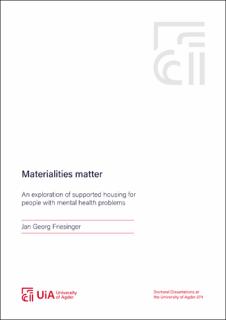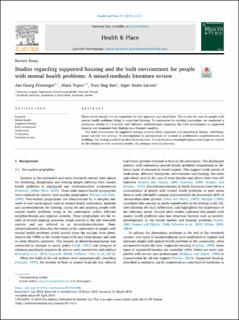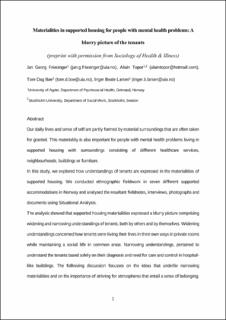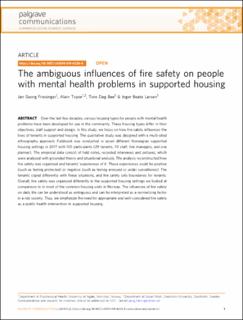| dc.contributor.author | Friesinger, Jan Georg | |
| dc.date.accessioned | 2020-05-22T19:09:33Z | |
| dc.date.available | 2020-05-22T19:09:33Z | |
| dc.date.created | 2020-04-30T21:50:03Z | |
| dc.date.issued | 2020 | |
| dc.identifier.citation | Friesinger, J. G. (2020). Materialities matter: An exploration of supported housing for people with mental health problems (Doctoral thesis). University of Agder, Kristiansand. | en_US |
| dc.identifier.isbn | 978-82-7117-975-5 | |
| dc.identifier.issn | 1504-9272 | |
| dc.identifier.uri | https://hdl.handle.net/11250/2655383 | |
| dc.description.abstract | Background: In the second half of the twentieth century, supported housing was founded as a comprehensive approach to people with mental health problems, who could receive help in the communities. These living places are situated in post-asylum geographies and differ not only in regard to the quality of healthcare services but also in regard to their ordinary materialities, such as surroundings, buildings, rooms and objects.
Aim: The aim of this thesis was to explore and understand how materialities in terms of the human–nonhuman interplay influence the living situations of people with mental health problems as tenants in supported housing. This overall research problem was addressed by three studies, each from a different angle.
Methods: Study I had an international focus and consisted of a mix-method literature review of studies on supported housing and the built environment. Studies II-III had a local focus and consisted of a multi-sited ethnography of seven supported housing settings in Norway. The analysis was informed by Grounded Theory approaches, whereby study II illuminated understandings of tenants expressed in materialistic, while study III examined the organisation and influences of materialities with respect to fire safety that were highlighted by the tenants themselves.
Findings: The findings of each study showed how materialities might influence the tenants’ living situations in various ways. To begin, the included literature in the mixmethod review indicated that the built environment is significant for tenants’ wellbeing, social identity and privacy, and it could thereby have different potentials for them regarding neighbourhood qualities and (congregate or independent) housing types. Then, the multi-sited Norwegian studies demonstrated that materialities of supported housing could present a blurry picture of tenants in a range from stereotypes to individuals. In addition, fire safety in terms of an all-embracing network could have ambiguous influences on tenants’ daily lives. Lastly, the studies together pointed out that materialities matter in multiple and contradicting ways. The materialities of supported housing that are involved in social interactions, relations and practices, as well as how they are experienced, shape the living situations of the tenants in ways that could be both limited and expanded. Nonetheless, the materialities of supported housing could make a contribution by placing tenants in relatively stable living situations and allowing them to create a meaningful place they could call home.
Conclusion: The thesis illuminated how materialities of supported housing matter for people with mental health problems in their daily lives. For those involved in the planning, building and administration of supported housing, it is important to consider the wholeness of these places in terms of both the inside and outside of supported housing. In other words, the surroundings, buildings, rooms and objects of supported housing are assembled in a broader social geography that could help tenants to express themselves as worth respecting citizens with their own identities. This social geography must therefore include ordinary materialities of supported housing as being arguably meaningful for people with mental health problems in the processes of their own becoming, both within healthcare services and in the spaces beyond them. | en_US |
| dc.language.iso | eng | en_US |
| dc.publisher | 07 Media | en_US |
| dc.relation.ispartofseries | Doctoral Dissertation at the University of Agder; no. 274 | |
| dc.relation.haspart | Friesinger, J. G., Topor, A., Bøe, T. D. & Larsen, I. B. (2019). Studies regarding supported housing and the built environment for people with mental health problems: A mixed-methods literature review. Health & Place, 57, 44–53. doi: https://doi.org/10.1016/j.healthplace.2019.03.006. Published version. Full-text is available in AURA as a separate file: . | en_US |
| dc.relation.haspart | Friesinger, J. G., Topor, A., Bøe, T. D. & Larsen, I. B. (Forthcoming). Materialities in supported housing for people with mental health problems: A blurry picture of the tenants. Sociology of Health & Illness. Author´s submitted manuscript. Full-text is not available in AURA as a separate file. | en_US |
| dc.relation.haspart | Friesinger, J. G., Topor, A., Bøe, T. D. & Larsen, I. B. (2019). The ambiguous influences of fire safety on people with mental health problems in supported housing. Palgrave Communications, 5: 22. doi: https://doi.org/10.1057/s41599-019-0230-0. Published version. Full-text is available in AURA as a separate file: https://hdl.handle.net/11250/2648696. | en_US |
| dc.title | Materialities matter : An exploration of supported housing for people with mental health problems | en_US |
| dc.type | Doctoral thesis | en_US |
| dc.description.version | publishedVersion | en_US |
| dc.rights.holder | © 2020 Jan Georg Friesinger | en_US |
| dc.subject.nsi | VDP::Medisinske Fag: 700::Helsefag: 800 | en_US |
| dc.source.pagenumber | 170 | en_US |
| dc.source.issue | 274 | en_US |
| dc.identifier.cristin | 1808978 | |



